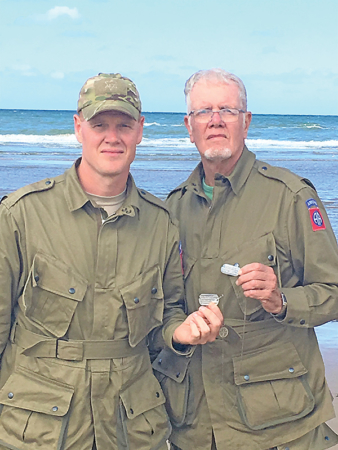We landed at the Paris airport a little after 7:00 a.m. We had been instructed to look for a man carrying a sign with our names. Those of you who have traveled to larger airports are familiar with the sights of men holding up signs to meet strangers. Yes, here we were in a country I had never been, couldn’t speak the language and couldn’t find the driver we were to meet.
Undeterred, we pressed on until finally spotting a man carrying a sign reading ‘D-Day Memory Tour, Scott and Doug.’ Yep, that was us. While traveling an hour’s journey to our downtown hotel, we engaged in a spirited conversation comparing notes on politics, educational comparisons, and gaining a little understanding of Parisian life.
Our hotel destination, Hotel D’ Albion, was a small building on a narrow, crowded street. It was built in 1845, its rooms small but comfortable. Luckily, breakfast was still available, but quite different than what a breakfast spread would be at an American hotel. We ate, rested a bit, and since we only had one day to explore Paris, we soon departed on an eight-mile walking tour of the city.
Our first stop was the famed Arc D’ Triumph through which my Dad and thousands of Allied troops marched when Paris was liberated. Pictures were taken, and that sight was my first of what would prove to be many moving experiences.
As we continued, we visited the Eiffel Tower, the Seine River, the Place De I’Etoile (the residence of the French president), saw the site where Diana, Princess of Wales was killed in a 1997 car crash, and took a lengthy stroll along the wide streets of the Champs-Elysees. Tired from a long day’s experience, we dined on pizza and crashed for some much-needed sleep.
The next morning we headed for the Saint-Lazare train station and our trip to Normandy. The station is a large impressive looking building linking Paris with communities in western France. While waiting for our departure time, I headed for the restroom (called water closets) only to find that the facilities required payment of a fee. Having no Euros, I had to relocate Doug to gain the needed funding. Mission completed and a lesson learned.
After a relaxing 2-1/2 hour train ride, we arrived in Carentan, Normandy, to meet our host J.P. Paviot and his brother Oliver. J.P. was a former member of the French military and businessman who, a few years earlier, came up with the idea to offer a Normandy experience like no other. The pair were about to lead us on a seven-day adventure using WWII jeeps that would include staying in a 14th-century castle and French manors once occupied by the Germans, pitching tents at an encampment, traveling back roads and paths inaccessible by other means and standing on the very sites where the struggles of D-Day took place.
Our traveling party was small, which made it even more enjoyable. In addition to J.P. and Oliver, our three-jeep caravan consisted of Gary and Carol (a farmer and retired school teacher from Michigan; Ron (a retired New York City policeman); Doug and me. All had military backgrounds.
An interesting note having nothing to do with our tour; when talking with Ron about his police experiences, we asked him if he had ever been assigned to Times Square on New Year’s Eve. “Too many times,” was his response. He went on to explain that each year, 6,000 uniformed officers and many plain-clothed officers are sent to patrol the event that draws between 1 and 2 million people each year.
Asked about restrooms, “There are none,” he said. He further added the entire Times Square area is roped off. Once inside that area, that’s where you stay until after the ball drops. Think about that should you ever decide to go.
The remainder of our first day in Normandy was spent relaxing and getting to know each other. We would be taken to a restaurant for dinner but would be surprised to learn we wouldn’t be eating until 9:00 p.m. During our entire stay, the evening meal was always served that late. That, coupled with the fact that is was still light at 10:30 p.m., took our body clock some time to get used to.
Following the meal, the real history of what we were about to experience began. At midnight a jeep ride took us to one of the jump zones used by the 82nd and 101st paratroopers landing behind the German lines in the wee hours of June 6, 1944. J.P. wanted us to see what it was like on that historic evening. It was still, dark, and silent. Standing there, trying to imagine what it was like for these brave men jumping into an unfamiliar hostile area sent the mind racing with genuine appreciation.
It was explained that the Germans had taken control of a river lock system and flooded the surrounding countryside, further complicating conditions for the paratroopers. We were also taken to landing areas where the Allied gliders landed. These gliders carried the needed ammunition, vehicles, and supplies the advancing troops would need. Most landed safely, while some would crash with the occupants either killed or captured by the enemy.
In the following days, those past history lessons contained in books truly came alive. I had heard of German bunkers but never really understood their magnitude. Not far from Omaha Beach, we explored a German bunker that from the sky looked like a grassy field. Underneath this façade, it was massive, at least three or four football fields long. Four hundred Germans had manned it with its armaments directly honed in on the beachheads.
For me, the most chilling moments came during our visit to Omaha Beach.
As we approached, the path led us to the tops of the cliffs overlooking the beach below. Our arrival was scheduled to coincide with the low tide conditions that greeted the landing forces at dawn on June 6. Doug and I proceeded down the steep terrain onto the sandy beach. We walked out to the water’s edge silently, deep in thought.
I had brought along my Dad’s WWII dog tags, the same ones he wore when he stepped on this very beach 75 years ago. I placed them in the sand and stared out into the vast water before me. Doug had brought along a container to scoop up sand from the beach. No one said a word.
After some time had passed, Doug said, “Dad, we are going to storm the beach.” He instructed me to walk ahead of him, holding my Dad’s dog tags. From behind, he filmed our walk across Omaha Beach. When we reached the foot of the cliffs above, he told me it had taken us 6 1/2 minutes to reach this point from the water’s edge.
Looking back to the water, my feelings were indescribable. That 6 1/2 minute walk came with us carrying no equipment — and no one was shooting at us from above. The thoughts of what it must have been like. To me, it seemed like suicide. For all too many, it was. In round numbers that D-Day morning resulted in 1,000 dead, 1,000 wounded, and another 1,000 missing in action and presumed dead.
As I pondered, it didn’t seem right at what I was now looking at. People were enjoying picnics, sunbathing, and riding dune buggy-like vehicles across these very sands where so many had died. I expressed my feelings to J.P. His answer put things in perspective.
“Scott,” he said, “It is because of what those very brave men did that these people are able to enjoy what they are doing today.”
As I silently looked back upon the beach, I truly realized that indeed ‘freedom is not free.’
(Note: This is the second of a four-part story of my July Normandy experience re-tracing the path my father, Ralph N. Lowery, took as a member of the Pennsylvania 28th Division during World War II.)





Leave a Comment
Your email address will not be published. Required fields are marked with *